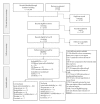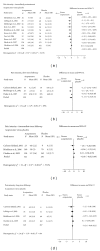A systematic review and meta-analysis of efficacy, cost-effectiveness, and safety of selected complementary and alternative medicine for neck and low-back pain - PubMed (original) (raw)
doi: 10.1155/2012/953139. Epub 2011 Nov 24.
Fatemeh Yazdi, Alexander Tsertsvadze, Anita Gross, Maurits Van Tulder, Lina Santaguida, Joel Gagnier, Carlo Ammendolia, Trish Dryden, Steve Doucette, Becky Skidmore, Raymond Daniel, Thomas Ostermann, Sophia Tsouros
Affiliations
- PMID: 22203884
- PMCID: PMC3236015
- DOI: 10.1155/2012/953139
A systematic review and meta-analysis of efficacy, cost-effectiveness, and safety of selected complementary and alternative medicine for neck and low-back pain
Andrea D Furlan et al. Evid Based Complement Alternat Med. 2012.
Abstract
Background. Back pain is a common problem and a major cause of disability and health care utilization. Purpose. To evaluate the efficacy, harms, and costs of the most common CAM treatments (acupuncture, massage, spinal manipulation, and mobilization) for neck/low-back pain. Data Sources. Records without language restriction from various databases up to February 2010. Data Extraction. The efficacy outcomes of interest were pain intensity and disability. Data Synthesis. Reports of 147 randomized trials and 5 nonrandomized studies were included. CAM treatments were more effective in reducing pain and disability compared to no treatment, physical therapy (exercise and/or electrotherapy) or usual care immediately or at short-term follow-up. Trials that applied sham-acupuncture tended towards statistically nonsignificant results. In several studies, acupuncture caused bleeding on the site of application, and manipulation and massage caused pain episodes of mild and transient nature. Conclusions. CAM treatments were significantly more efficacious than no treatment, placebo, physical therapy, or usual care in reducing pain immediately or at short-term after treatment. CAM therapies did not significantly reduce disability compared to sham. None of the CAM treatments was shown systematically as superior to one another. More efforts are needed to improve the conduct and reporting of studies of CAM treatments.
Figures
Figure 1
Flow diagram.
Figure 2
Figure 3
Acupuncture versus no treatment for chronic nonspecific low-back pain (Pain intensity: Visual Analogue Scale).
Figure 4
Acupuncture versus placebo for chronic nonspecific low-back pain (Pain intensity: Visual Analogue Scale).
Figure 5
Acupuncture versus Manipulation for chronic nonspecific low-back pain (Pain intensity: Visual Analogue Scale).
Figure 6
Acupuncture versus placebo for chronic-specific and nonspecific neck pain (Pain intensity: Visual Analogue Scale).
Figure 7
Funnel plot of trials comparing VAS score (acupuncture versus placebo).
Similar articles
- Complementary and alternative therapies for back pain II.
Furlan AD, Yazdi F, Tsertsvadze A, Gross A, Van Tulder M, Santaguida L, Cherkin D, Gagnier J, Ammendolia C, Ansari MT, Ostermann T, Dryden T, Doucette S, Skidmore B, Daniel R, Tsouros S, Weeks L, Galipeau J. Furlan AD, et al. Evid Rep Technol Assess (Full Rep). 2010 Oct;(194):1-764. Evid Rep Technol Assess (Full Rep). 2010. PMID: 23126534 Free PMC article. Review. - Noninvasive Nonpharmacological Treatment for Chronic Pain: A Systematic Review [Internet].
Skelly AC, Chou R, Dettori JR, Turner JA, Friedly JL, Rundell SD, Fu R, Brodt ED, Wasson N, Winter C, Ferguson AJR. Skelly AC, et al. Rockville (MD): Agency for Healthcare Research and Quality (US); 2018 Jun. Report No.: 18-EHC013-EF. Rockville (MD): Agency for Healthcare Research and Quality (US); 2018 Jun. Report No.: 18-EHC013-EF. PMID: 30179389 Free Books & Documents. Review. - A review of the evidence for the effectiveness, safety, and cost of acupuncture, massage therapy, and spinal manipulation for back pain.
Cherkin DC, Sherman KJ, Deyo RA, Shekelle PG. Cherkin DC, et al. Ann Intern Med. 2003 Jun 3;138(11):898-906. doi: 10.7326/0003-4819-138-11-200306030-00011. Ann Intern Med. 2003. PMID: 12779300 Review. - Noninvasive Treatments for Low Back Pain [Internet].
Chou R, Deyo R, Friedly J, Skelly A, Hashimoto R, Weimer M, Fu R, Dana T, Kraegel P, Griffin J, Grusing S, Brodt E. Chou R, et al. Rockville (MD): Agency for Healthcare Research and Quality (US); 2016 Feb. Report No.: 16-EHC004-EF. Rockville (MD): Agency for Healthcare Research and Quality (US); 2016 Feb. Report No.: 16-EHC004-EF. PMID: 26985522 Free Books & Documents. Review. - Efficacy of spinal manipulation and mobilization for low back pain and neck pain: a systematic review and best evidence synthesis.
Bronfort G, Haas M, Evans RL, Bouter LM. Bronfort G, et al. Spine J. 2004 May-Jun;4(3):335-56. doi: 10.1016/j.spinee.2003.06.002. Spine J. 2004. PMID: 15125860 Review.
Cited by
- Acupuncture for spinal cord injury and its complications: a systematic review and meta-analysis of randomized controlled trials.
Heo I, Shin BC, Kim YD, Hwang EH, Han CW, Heo KH. Heo I, et al. Evid Based Complement Alternat Med. 2013;2013:364216. doi: 10.1155/2013/364216. Epub 2013 Feb 17. Evid Based Complement Alternat Med. 2013. PMID: 23476688 Free PMC article. - Comparisons of the Effectiveness and Safety of Tuina, Acupuncture, Traction, and Chinese Herbs for Lumbar Disc Herniation: A Systematic Review and Network Meta-Analysis.
Mo Z, Li D, Zhang R, Chang M, Yang B, Tang S. Mo Z, et al. Evid Based Complement Alternat Med. 2019 Mar 20;2019:6821310. doi: 10.1155/2019/6821310. eCollection 2019. Evid Based Complement Alternat Med. 2019. PMID: 31015852 Free PMC article. Review. - Acupuncture as an alternative or in addition to conventional treatment for chronic non-specific low back pain: A systematic review and meta-analysis.
Giovanardi CM, Gonzalez-Lorenzo M, Poini A, Marchi E, Culcasi A, Ursini F, Faldini C, Di Martino A, Mazzanti U, Campesato E, Matrà A, Cevoli S, Benedetti MG. Giovanardi CM, et al. Integr Med Res. 2023 Sep;12(3):100972. doi: 10.1016/j.imr.2023.100972. Epub 2023 Jul 7. Integr Med Res. 2023. PMID: 37637183 Free PMC article. Review. - Acupuncture therapy: mechanism of action, efficacy, and safety: a potential intervention for psychogenic disorders?
Kawakita K, Okada K. Kawakita K, et al. Biopsychosoc Med. 2014 Jan 20;8(1):4. doi: 10.1186/1751-0759-8-4. Biopsychosoc Med. 2014. PMID: 24444292 Free PMC article. - Return to Golf After Lumbar Fusion.
Shifflett GD, Hellman MD, Louie PK, Mikhail C, Park KU, Phillips FM. Shifflett GD, et al. Sports Health. 2017 May/Jun;9(3):280-284. doi: 10.1177/1941738116680200. Epub 2016 Nov 1. Sports Health. 2017. PMID: 27879299 Free PMC article.
References
- Andersson GB. Epidemiological features of chronic low-back pain. Lancet. 1999;354(9178):581–585. - PubMed
- Luo X, Pietrobon R, Sun SX, Liu GG, Hey L. Estimates and patterns of direct health care expenditures among individuals with back pain in the United States. Spine. 2004;29(1):79–86. - PubMed
- Dagenais S, Caro J, Haldeman S. A systematic review of low back pain cost of illness studies in the United States and internationally. Spine Journal. 2008;8(1):8–20. - PubMed
- Ricci JA, Stewart WF, Chee E, Leotta C, Foley K, Hochberg MC. Back pain exacerbations and lost productive time costs in United States workers. Spine. 2006;31(26):3052–3060. - PubMed
- Stewart WF, Ricci JA, Chee E, Morganstein D, Lipton R. Lost productive time and cost due to common pain conditions in the US workforce. Journal of the American Medical Association. 2003;290(18):2443–2454. - PubMed
LinkOut - more resources
Full Text Sources






